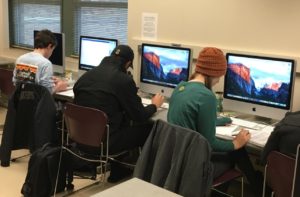The 2015 staff of the MHS Mirror newspaper stands in the halls of Mattoon High School for our annual photo. Several would go on to major in journalism, at least for a while, and one would end up in my first college news writing classroom.
IJEA Blog: Teaching my journalism students—again
Reflecting on power, purpose of scholastic to collegiate programs
October 11, 2017

It was as surprising to them as it was to me.
Two of my former high school journalists were now in my college section of news writing. I was thrilled, and I was hoping they were as well.
As the semester progressed, and those first awkward moments of nomenclature (do we call her Mrs., Instructor, Professor?) were resolved, I began to encounter wave after wave of epiphanies.
These were students who had learned journalism from me. And with the exception of a few conferences or sets of contest feedback, I was their only source of journalistic knowledge.
How would they fare in a college setting — a daily newspaper, a nightly newscast — with more advanced critiques of their ledes, quote selection, editing skills and more?
When I started providing formative feedback to my “again” students’ work, now through a university and professional journalist lens, the results weren’t perfect. Not everything I taught sunk in. They still started ledes with dates and times, they forgot basic elements of AP Style, they didn’t fact check when the error was obvious, and they weren’t always following the biggest news events in our world (even though news quizzes were a hallmark of our high school publications paradigm).
Yet, in the moments before I gave up my eight years in scholastic journalism for naught, the last wave crashed over me.
My high school journalism students — who were now my college journalism students — had learned perhaps the most vital learning objectives of all from our chaotic, underfunded and patchwork publications classroom. Those lessons had nothing to do with a complete skill set or superior subject-matter knowledge; they had everything to do with what the next generation of journalists needs to correct the trajectory of the craft.
What do scholastic journalism programs provide that is of the MOST value (and should be the “rubric” advisers use to gauge their success)?

- A love of the craft of journalism
- A sense of empathy for others
- A deeper knowledge of the world
- An understanding of process to reach a goal
The knack for writing a flawless lede will come with practice, as will a sense of AP style that doesn’t require our beloved stylebook to even be opened. Journalism majors (and others who come from our scholastic programs) will start double-checking, seeing the errors, and will eventually follow more leaders and news organizations on Twitter than personal friends.
But these are all techniques and tools that are a natural outgrowth of the much bigger lessons of the heart and mind that students learn in high school, that carry them into the college setting and beyond.
Are many scholastic journalism advisers too hard on themselves?
Maybe.
Are these same advisers teaching what really matters regardless of their personal competency with InDesign, deep background or F-Stops?
Absolutely.
The very nature of a newsroom will lead to these outcomes – which truly are the key to everything for the next generation.

Carol Smith • Oct 15, 2017 at 7:20 am
Another prime example of your communicating skills!